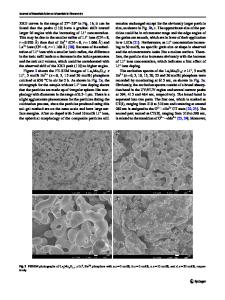Structural and photoluminescence properties of Eu 3+ activated ZnAl 2 O 4 orange-red phosphor
- PDF / 3,269,970 Bytes
- 13 Pages / 595.276 x 790.866 pts Page_size
- 89 Downloads / 321 Views
Structural and photoluminescence properties of Eu3+ activated ZnAl2O4 orange‑red phosphor Sanjay Kumar Pathak1 · Akshkumar Verma1 · Ashish Verma1 Received: 24 December 2019 / Accepted: 1 June 2020 © Springer Science+Business Media, LLC, part of Springer Nature 2020
Abstract Europium doped zinc aluminum oxide (Zn0.93Al2O4:Eu0.07) was successfully prepared by a combustion method at 550 °C, in which urea, glycine, urea–glycine, citric acid, carbohydrazide, tartaric acid, carbohydrazide–glycine, oxalic acid–glycine, and tetraformaltrisazine were used as a fuel (complexing reagents). The structural and morphological properties were measured and elemental analysis carried out using X-ray diffraction (XRD), scanning and transmission electron microscopy (SEM and TEM) and energy-dispersive X-ray (EDX), respectively. The photoluminescence (PL) spectra were monitored by excitation spectra (λex. = 378 nm) and emission spectra (λem. = 614 nm), to assess various complexing reagents in which urea was found to be the most efficient for synthesizing ZnAl2O4:Eu3+orange-red phosphor. The discussed zinc aluminate (U-1) phosphor has a higher luminescence intensity at 614 nm. It is concluded, therefore, that the Z nAl2O4:Eu phosphor can be used widely in various solid-state lighting as an orange-red phosphor.
1 Introduction Material science is considered as the backbone of science and technology. Technology depends on the physical and chemical characteristics of substances, and the method of modifying substances. Different technologies depend on different synthesized materials because the properties of the synthesized materials are greatly influenced by the synthesis technique [1–3]. Various phosphor substances are synthesized using different parameters and synthesis methods [1, 4]. Synthesized inorganic phosphors are known for their specificity of luminescence and useful properties. Some common substances such as borate, carbonate, phosphate, nitride, oxide, silicate, oxynitride, aluminates, sulfide, selenide, halide or oxyhalide, and tungstate, etc. are used to synthesize phosphors as host substances. Each phosphor substance that contains a host structure doped with a small amount of rare-earth and transition metal ions [5, 6]. Transition metals, rare-earth transition metals, and any metal that can activate the host are used as activators. Previous studies show that europium rare-earth transition metal has proved more useful than other activators [7–9]. * Sanjay Kumar Pathak [email protected] 1
Department of Physics, Dr. Harisingh Gour Vishwavidyalaya, Sagar, MP 470003, India
Since each synthesis method has a standard parameter based on which the materials are synthesized [1, 4], the physical properties of the formed materials also changes. Though, aluminates have been synthesized using various methods, combustion method has been found to be most suitable for aluminate-based phosphor substances [2, 4, 10]. There has been a lot of interest in aluminates due to their potential as materials with useful optical properties
Data Loading...











